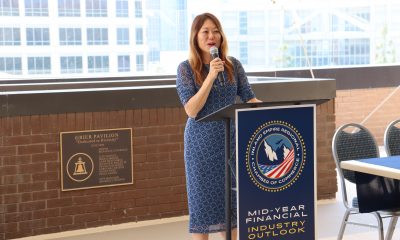Career & Workplace
Four Inland Empire Students to Receive 2021 SCAG Scholarships

Brenna Bell and Ryan Byrne of Murrieta, Gabriel Cao of Chino Hills and Andrew Ballard of Oak Hills were announced Thursday as Inland Empire winners of 2021 Southern California Association of Governments (SCAG) scholarships.
Bell, Byrne, Cao and Ballard were among 11 students from across Southern California who will receive $4,000 each in financial support.
The SCAG scholarship program, now in its 11th year, is intended to provide financial support to a select group of high school and community college students who have expressed interest in urban planning and public policy as part of their long-term career goals. The scholarship winners were announced at SCAG’s Regional Council meeting.
“We’re honored to have the opportunity to help these students in the next stage of their academic journeys. They are remarkable young adults and future leaders for our region,” said Clint Lorimore, SCAG President, an Eastvale City Councilmember and member of the SCAG Scholarship Committee.
As part of the application process, students were required to submit a completed application form; a minimum 500-word essay, two letters of recommendation and a current academic transcript.
Bell graduates Thursday from Murrieta Valley High School and will attend Claremont McKenna College, majoring in environment, economics and politics.
She wrote that her intended field of study “will allow me to study how to fight for what I think should be prioritized – the environment – and will aid me in figuring out how to create and implement regulations that will be cost-efficient for the economy … Seeing the environment not being taken care of concerns me, and I plan on using my career to do what I can against that.”
Byrne graduates Friday from Murrieta Valley High School and will attend Loyola Marymount University or American University, majoring in political science.
“For several years now, I have been active in my community using my voice to speak out for those in need; to use my passion for public policy and government to help those who are struggling,” he wrote. “I hope that working for a government entity or private group can give me further insight into how government and policy making can be a force for good.
Cao graduated from Ruben S. Ayala High School in Chino Hills and plans to major in political science.
He wrote that he plans to pursue a career in legislation, at the Congressional or state level, “to protect the civil liberties of the people. Working closely with the laws that govern the people, I aspire to be a force that pushes us closer to solving these issues, however small my contributions may be. In my future of public policy, I hope only to serve as an instrument of the people and advocate for their best interests.”
Ballard graduated from Oak Hills High School and will attend California State Polytechnic University, Pomona, majoring in mechanical engineering. His scholarship was funded through a partnership with the California Transportation Foundation.
“Leadership is one element I feel that is important to exhibit in order for a volunteer, government official or other stakeholder to allocate resources to shape the positive advancement of a community,” Ballard wrote. “My goal is to work in public service for the U.S. Department of Energy, preserving environmental resources and developing clean power to advance the nation.”
In addition to Lorimore, this year’s SCAG Scholarship Committee was comprised of 15 Regional Council members and three representatives from education and business. On the committee from the Inland Empire were: Curt Hagman, Chairman of the San Bernardino County Board of Supervisors; SCAG First Vice President Jan Harnik, representing the Riverside County Transportation Commission; Kathleen Kelly, representing the Coachella Valley Council of Governments; Steve Manos, representing the Western Riverside Council of Governments; and Ray Marquez and Larry McCallon, representing the San Bernardino County Transportation Authority.
Career & Workplace
California Continues to Struggle with Labor Supply as Employment Expands Modestly

State’s Unemployment Rate Remains Highest In Nation
California’s labor market expanded modestly in April, with total nonfarm employment in the state growing by 5,200 positions over the month, according to an analysis released today by Beacon Economics. March’s gains were revised down to 18,200 in the latest numbers, a 10,100 decline from the preliminary estimate of 28,300.
As of April 2024, California has recovered all of the jobs that were lost in March and April 2020, and there are now 314,300 more people employed in the state compared to February 2020. Total nonfarm employment has grown 1.8% over this time compared to a 3.9% increase in the United States overall. California increased payrolls by 1.2% from April 2023 to April 2024, trailing the 1.8% increase nationally over the same period.
The state’s unemployment rate held steady at 5.3% in April 2024, unchanged from the previous month. California’s unemployment rate is the highest in the nation and remains elevated relative to the 3.9% rate in the United States as a whole. The state continues to struggle with its labor supply, which remained essentially unchanged in April (declining by a negligible 100). Since February 2020, California’s labor force has fallen by -246,200 workers, a -1.3% decline. In comparison, over the past twelve months the nation’s labor force has increased by 0.8%.
Industry Profile
- At the industry level, job gains were mixed in April. Health Care led the way with payrolls expanding by 10,100, an increase of 0.4% on a month-over-month basis. With these gains Health Care payrolls are now 13.6% above their pre-pandemic peak.
- Other sectors posting strong gains during the month were Transportation, Warehousing, and Utilities (3,700 or 0.4%), Leisure and Hospitality (3,100 or 0.2%), Government (2,600 or 0.1%), Education (1,800 or 0.4%), Retail Trade (1,000 or 0.1%), and Wholesale Trade (400 or 0.1%).
- Payrolls decreased a handful of sectors in April. Construction experienced the largest declines, with payrolls falling by -6,000, a contraction of -0.6% on a month-over-month basis. Note that this decline was largely due to late season storms affecting construction projects across the state.
- Other sectors posting significant declines during the month were Manufacturing (-5,300 or -0.4%), Professional, Scientific, and Technical Services (-3,600 or -0.3%), Real Estate (-700 or -0.2%), Finance and Insurance (-700 or -0.1%), Administrative Support (-600 or -0.1%), and Information (-600 or -0.1%).
Regional Profile
- Regionally, job gains were led by Southern California. Los Angeles (MD) saw the largest increase, where payrolls grew by 5,700 (0.2%) during the month. The Inland Empire (2,600 or 0.2%) and San Diego (1,200 or 0.1%) also saw their payrolls jump during the month. However, payrolls fell in Orange County (-2,700 or -0.2%), Ventura (-500 or -0.2%), and El Centro (-2,200 or -0.3%). Over the past year, El Centro (1.9%) has had the fastest job growth in the region, followed by the Inland Empire (1.5%), Ventura (1.4%), Orange County (1.1%), San Diego (0.8%), and Los Angeles (MD) (0.6%).
- In the Bay Area, the East Bay experienced the largest increase, with payrolls expanding by 2,600 (0.2%) positions in April. San Rafael (MD) (200 or 0.2%) and Napa (100 or 0.1%) also saw payrolls increase during the month. However, San Francisco (MD) (-1,700 or -0.1%), Santa Rosa (-600 or -0.3%), and Vallejo (-600 or -0.2%) experienced payroll declines during the month. Over the past 12 months, Vallejo (3.0%) enjoyed the fastest job growth in the region, followed by Santa Rosa (2.3%), Napa (2.2%), San Rafael (MD) (1.6%), the East Bay (0.9%), San Jose (0.2%), and San Francisco (MD) (-0.8%).
- In the Central Valley, Sacramento experienced the largest monthly increase as payrolls expanded by 900 (0.1%) positions in April. Payrolls in Yuba (400 or 0.8%), Bakersfield (300 or 0.1%), Fresno (300 or 0.1%), and Visalia (100 or 0.1%) increased as well. However, payrolls fell in Stockton (-500 or -0.2%), Modesto (-200 or -0.1%), Merced (-200 or -0.3%), Redding (-100 or -0.1%), and Hanford (-100 or -0.2%). Over the past year, Madera (5.7%) had the fastest growth, followed by Yuba (4.2%), Merced (3.7%), Modesto (3.6%), Sacramento (2.5%), Hanford (2.4%), Redding (2.3%), Fresno (2.2%), Visalia (2.1%), Stockton (2.0%), Chico (1.5%), and Bakersfield (1.1%).
- On California’s Central Coast, Salinas (200 or 0.1%) and Santa Cruz (200 or 0.2%) added the largest number of jobs during the month. Santa Barbara (-100 or -0.1%) saw payrolls decline. From April 2023 to April 2024, Salinas (1.9%) has added jobs at the fastest rate, followed by Santa Cruz (1.6%), Santa Barbara (0.8%), and San Luis Obispo (0.5%).
Career & Workplace
Inland Economic Growth & Opportunity (IEGO) Announces 2024 Priorities

Strategic Vision: Prioritizing Sustainable Growth and Enhanced Opportunities in the Inland Region
The Inland Economic Growth & Opportunity (IEGO), a collaborative organization dedicated to fostering economic growth, has announced its 2024 strategic priorities designed to create a vibrant, inclusive, and sustainable economy for Southern California’s Inland Empire. Among its immediate priorities include its role in Governor Newsom’s California Jobs First regional jobs strategy.
“As one of the California Jobs First statewide collaboratives, IEGO is committed to engaging a wide ranging and diverse group of stakeholders in our economic development focus so that we can improve the quality of life for all residents across the region,” said IEGO Executive Director Matthew Mena.
IEGO’s strategy is critical. While Inland Southern California remains one of California’s top job growth markets, it also ranks as having the lowest average weekly wages according to employment data for the nation’s 50 largest county job markets as reported by the US Bureau of Labor Statistics.
The IEGO 2024 priorities are designed to counter that trend and encourage greater business investment, including:
California Jobs First: IEGO will develop Inland Southern California’s regional jobs strategy to create quality jobs and a more accessible economy as part of Governor Newsom’s very intentional, inclusive approach to economic and workforce development to maximize state resources and investments by empowering communities to chart their own futures. Much of the funding will support career development projects from capacity building to industry-specific programs, and new job training.
Center of Excellence: As one of the state’s designated Center of Excellence, IEGO will support the region’s community colleges and their partners by providing research on the local labor market, including information on job growth, wages, demographics, top employers, education, and skill requirements, as well as education outcomes for industries and occupations critical to the Inland Empire’s economy. This data will help inform the development of new community college programs, curriculum, and partnerships that the colleges pursue in their efforts to prepare residents for high-paying, fast-growing jobs that Inland Empire businesses need today and in the future.
Regional Marketing: IEGO will work to ensure that the region is well positioned to benefit from public and private investment and is fully recognized for its economic strength and opportunity. In this way, IEGO can enhance the delivery of public and private resources to the two-county region.
“There’s real opportunity for the IEGO Center of Excellence to lead deeper economic and workforce research. One of the immediate areas is our Top 50 Jobs report. We want to better identify the best job opportunities and pathways for workers in struggling families to make ends meet and build wealth,” said Andy Hall, who is leading report development for the Center of Excellence.
Career & Workplace
The City of Rancho Cucamonga Recognized as U.S. Best-in-Class Employer by Gallagher

Gallagher’s Best-in-Class Benchmarking Analysis Identifies U.S. Organizations That Excel in Optimizing Employee and Organizational Wellbeing
The City of Rancho Cucamonga participated in Gallagher’s 2023 U.S. Benefits Strategy & Benchmarking Survey and was identified as an organization that excelled in implementing successful strategies for managing people and programs. The City of Rancho Cucamonga was recognized for its comprehensive framework for strategically investing in benefits, compensation and employee communication to support the health, financial security and career growth of its employees at a sustainable cost structure.
Designations like Gallagher’s Best-in-Class Employer help current and potential employees understand and appreciate an organization’s workplace culture and people strategy; important differentiators as employers compete for talent in today’s labor market.
“This award is a testament to the collective dedication and unwavering commitment of our team, reflecting the high standards we uphold in fostering a workplace that thrives on innovation, belonging, and employee well-being.” Robert Neiuber, Senior Human Resources Director, City of Rancho Cucamonga.
A U.S. Best-in-Class Employer, the City of Rancho Cucamonga was assigned points based on its relative performance in:
- Plan horizons for benefits and compensation strategies
- Extent of the wellbeing strategy
- Turnover rate for full-time equivalents (FTEs)
- Completion of a workforce engagement survey
- Use of an HR technology strategy and its level of sophistication
- Difference in healthcare costs over the prior year
- Use of a communication strategy
The City of Rancho Cucamonga understands that high employee expectations haven’t budged in the changing labor market and have regularly examined their formula to attract and retain talent,” said William F. Ziebell, CEO of Gallagher’s Benefits & HR Consulting Division. “In doing so, the City of Rancho Cucamonga utilizes data, workforce feedback tools and clearly defined policies to provide competitive benefits and experiences that their employees value.”
-

 Opinion1 month ago
Opinion1 month agoSurge in Unemployment Among California Youth Linked to Minimum Wage Hikes
-

 Commercial Real Estate Transactions3 weeks ago
Commercial Real Estate Transactions3 weeks agoSRS Real Estate Partners Announces Record-Breaking $6.15 Million Ground Lease Sale of a New Construction Chick-fil-A Property in Murrieta, California
-

 Health & Wellness3 weeks ago
Health & Wellness3 weeks agoBuddha Bars: A Mother’s Innovative Solution to Healthy Snacking
-
By Press Release1 week ago
California Employment Expansion Continues But Still Trails Nation








